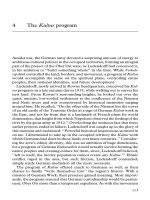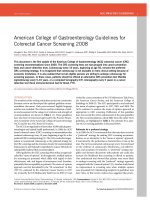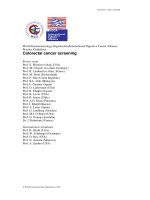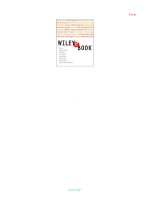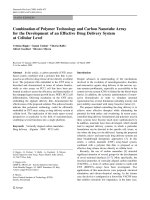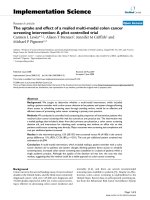The Flu-FIT Program: An Effective Colorectal Cancer Screening Intervention
Bạn đang xem bản rút gọn của tài liệu. Xem và tải ngay bản đầy đủ của tài liệu tại đây (5.72 MB, 38 trang )
80% by 18 Fourm
The Flu-FIT Program:
An Effective Colorectal Cancer Screening
Intervention
Michael B. Potter, MD
Director, SF Bay Area Collaborative Research Network
University of California, San Francisco
Sept 17, 2015
Atlanta, GA
Presentation of Overview
• The role of FIT in achieving US colorectal cancer
screening goals
• Development and pilot testing of the Flu-FIT
Program
• Research to demonstrate effective translation into
diverse clinical settings
• Dissemination and implementation activities
In USA, colonoscopy is the most common
screening modality, but FOBT remains
important
Decision modeling studies indicate that when
provided annually to average risk patients with
appropriate follow up, annual stool testing can
provide the same number of life-years gained
as colonoscopy-only strategies.
Zauber AG et.al. Ann of Int Med. 2008, 149; 659-669
FIT has advantages
•
•
•
•
Inexpensive and Accessible
Can be offered by any member of the health team
Can be done in privacy and at home
Is non-invasive and has no risk of pain, bleeding,
bowel perforation, or other adverse outcomes
• Fecal Immunochemical Tests (FIT) are easier and
better accepted than other stool-based tests (no
changes in diet required, for example)
• Only requires colonoscopy if abnormal
• Many patients prefer it.
Doing more FIT is especially important in
public health settings
(2014 NCCRT analysis of UDS data)
Challenges of Implementing FIT Programs
in Primary Care
•
•
•
•
•
•
•
•
Select and invest in evidence-based FIT kits
Identify eligible patients
Organized in-reach and outreach
Staff training to educate patients about the
importance of screening and how to do the test
Follow-up to assure test completion
Assure high quality test development processes.
Assure annual test completion if normal
Follow up abnormal results with colonoscopy
Developing a new screening program
The first CLINICAL questions (2004):
What primary care colorectal cancer screening
outreach program could be
a. effective for an under-screened population?
b. acceptable to clinicians and staff?
c. feasible to implement with limited resources?
d. complementary to other quality improvement
efforts?
e. sustainable after the researchers leave?
f. adaptable and scalable for diverse settings?
The first RESEARCH questions (2005-6):
1. For average risk adults, is the time of influenza
vaccination a missed opportunity to offer colorectal
cancer screening?
2. Can we show that a “FLU-FOBT Program” in an
influenza vaccination clinic can work?
Potential increase in CRC screening for adults
eligible if offered with influenza vaccination
(Combines CA BRFSS and SF General Hospital Data)
Presented at the SF Bay Area Clinical Research Symposium, 2006
San Francisco General Hospital’s
Family Health Center
Flu is Preventable! Colon Cancer is Preventable!
•Yearly home stool tests are easy to do.
•Yearly home stool tests could save your life.
•All our doctors and nurses recommend Colon
Screening for healthy men and women aged 50 to 79.
•When you should get tested? We will tell you today.
¡La Gripa es prevenible!
¡El cancer del colon es
prevenible!
•Es fácil hacerse exámenes
anuales de defecación.
•Los exámenes anuales de
defecación le pueden salvar la
vida.
•Todos nuestros doctores y
enfermeras recomiendan un
chequeo del colon para hombres y
mujeres en buen estado de salud
entre los 50 y 79 anos.
•Cuando necesita ser chequeado?
Nosotros se lo podemos decirr hoy.
流 流 流 流 流 流 流 流流流流 流流流流流流流流流
每每每每每每每每每 每每每每每每每每
每每每每每每每每每每每每每每每每每每
每 每 每每每每每每每每每每每 50 每每 79 每每每每每每 每每每每每每每每每每每每每
每 每 每 每 每 每 每每 每 每 每 每 每 每 每 每每
Có Thể Ngừa Được Cúm!
Có Thể Ngừa Được Ung Thư Ruột Giá!
•Xét nghiệm phân hằng năm làm dễ dàng.
•Xét nghiệm phân hằng năm có thể cứu sinh mạng quý vị.
•Bác sĩ và y tá đề nghị làm xét nghiệm ung thư ruột gìa cho những
người khỏe mạnh từ 50 đến 79 tuổi.
•“Quý vi nên đi khám lúc nào ? Chúng tôi sẽ cho quý vị biết hôm
nay!”
Грипп можно предотвратить! Рак толстой кишки можно предотвратить!∙
• Проводить ежегодно анализ кала очень просто.
•Проведение анализа кала ежегодно может спасти вам жизнь.
• Обследование с целью предотвращения рака толстой кишки рекомедуется докторами всем женщинам и
мужчинам в возрасте от 50 до 79 лет.
•Когда нужно сделать тест? Мы скажем Вам об этом сегодня.
Results – San Francisco General Hospital
6-month outcomes
Efficacy Study
Intent-to-treat analysis, all flu shot clinic patients
Flu Only Arm
N=246
Flu-FOBT Arm
N=268
CRCS Up-to-Date
Before (Oct 2006)
52.9%
54.5%
CRCS Up-to-Date
After (Mar 2007)
57.3%
84.3%
Change: p<0.001
+4.4 points
+29.8 points
Odds Ratio for going from unscreened to screened in
Multivariate Analysis:
11.3 (5.8-22.0)
CRCS up to date: FOBT within 12 months, FSIG within 5 years or colonoscopy within 10 years
Potter MB et al., Annals of Family Medicine, 2009.
The next questions (2008-2012), translating research
into practice:
1. Can it work without the research team?
2. Can it be integrated with primary care in public
health settings?
3. Can it work in managed care?
4. Can it work in pharmacies?
5. Can it be sustained and scaled up where it is
introduced?
FLU-FOBT and FLU-FIT Projects
•
San Francisco Dept of Public Health
– CDC R18 (2008-2011) “Translation of an Evidence-Based Colorectal Cancer
Screening Intervention to Primary Care Settings Where Disparities Persist”
•
Kaiser Permanente Northern California
– HMO Cancer Research Network (2008-2009) “Preparation for the FLU-FIT
Program at Kaiser Permanente Santa Clara”
– ACS Research Scholars Grant (2009-2012) “Colorectal Cancer Screening with
During Annual Flu Shot Clinics at Kaiser Permanente”
•
Walgreens Pharmacies
– Alexander and Margaret Stewart Trust (2008-2009) “A Pharmacy-Based
Intervention to Increase Colorectal Cancer Screening”
RCT in 6 public clinics in ethnically diverse and medically
underserved neighborhoods in San Francisco
Results – RCT in 6 public clinics
“real world conditions”
(Am J Prev Med, 2011)
Intent-to-treat analysis
Training from research team
Intervention run and supervised entirely by clinic staff
No post-intervention phone calls
Data for flu shot
recipients in 6 clinics
Flu Only Arm
N=677
Flu-FOBT Arm
N=695
CRCS Up-to-Date
before (Oct 2009)
31.3%
32.5%
CRCS Up-to-Date After
(Mar 2010)
35.6%
45.5%
+4.3 points
+13.0 points
Change (p=0.02)
Odds Ratio for going from unscreened to screened in
Mulitivariate Analysis: 2.22 (1.24-3.95)
“Up to date” = FOBT within 1yr, FSIG within 5yr,or colonoscopy within 10yr
Evidence of Lasting Benefits
(Health Educ Research , 2012)
Observational Data -- Established patients aged 50-75
Population data for 6 clinics
that participated in the
FLU-FOBT RCT
Number of Flu Shot
Recipients
N
CRCS Up-To-Date Among
Flu Shot Recipients
N (%)
March 2008 (before)
3260
1385 (42.5%)
March 2009 (after)
3634
1982 (54.5%)
March 2010 (1 yr later)
4333
2440 (55.8%)
More Patients got flu shots and CRC screening over time
More knowledgeable clinic teams
Many Adaptations (e.g. most sites switched from older less effective FOBT to
FIT by 2011, adjusted workflows, and some initiated year-round standing
orders for staff to offer screening with FIT)
“Up to date” = FOBT within 1yr, FSIG within 5 yr, or colonoscopy within 10 yr
Flu-FIT Program at
Kaiser Permanente
The Flu-FIT “Assembly Line”-- Used electronic health records
to assess FIT eligibility while patients waited for flu shots
(Am J Managed Care, 2011)
RCT at Kaiser Permanente facilities in 5 different
California cities
Results – Kaiser Permanente RCT
(Am J Pub Health, 2012)
Intent-to-treat analysis. Nurse-run; No post-visit reminders
Test(s) completed
within 90 days
Flu Only Arm
N= 2884
Due for screening
Flu-FIT Arm
N=3351
Due for screening
P value
FIT
336 (11.7%)
900 (26.9%)
<0.001
Flex Sig
68 (2.4%)
62 (1.9%)
0.16
Colonoscopy
61 (2.1%)
86 (2.6%)
0.24
438 (15.2%)
996 (29.7%)
Any Test
<0.001
Odds Ratio: 2.77 (2.41-3.18); Outcomes similar for all demographic subgroups.
In the Intervention Arm:
53% of those due for screening were given a FIT kit
35% of those given a FIT kit completed it within 90 days.
2011 Dissemination and Implementation Study Targeting
All KPNC Facility Flu Shot Clinic Sites (Evaluation in Process)
Endorsed but not required by
KPNC Regional Leadership
Disseminated through Regional
Flu Shot Clinic Coordinators
Hands-on training offered at
KPNC’s Center for Innovation in
San Leandro, CA.
Webinar for new and
experienced flu shot clinic sites
Internal KPNC website with
KPNC-specific procedures and
downloadable materials created
Walgreens Pharmacy Pilot Study
moving Flu-FIT into community pharmacies
Results comparing Flu-FIT vs.
Flu plus Education/Referral for Screening
(J Am Pharm Assoc 2010;50:181-7)
Phone Interviews 3-6 months after the
Intervention
FIT
Provided
N=86
Education/
Referral
N=28
P value
Discussed Screening with Physician
20%
50%
<0.01
Completed Screening Test
59%
15%
<0.01
Scheduled Screening Test
0%
19%
<0.01
Said “Pharmacies should educate”
94%
86%
0.22
Said “Pharmacies should offer FIT”
91%
82%
0.30
Pharmacists could play a positive role in colorectal cancer screening:
educating, referring, and/or providing FIT to eligible patients
Challenges to address: methods to assess eligibility, closing the loop with
primary care, and providing incentives for pharmacies to offer these services.
